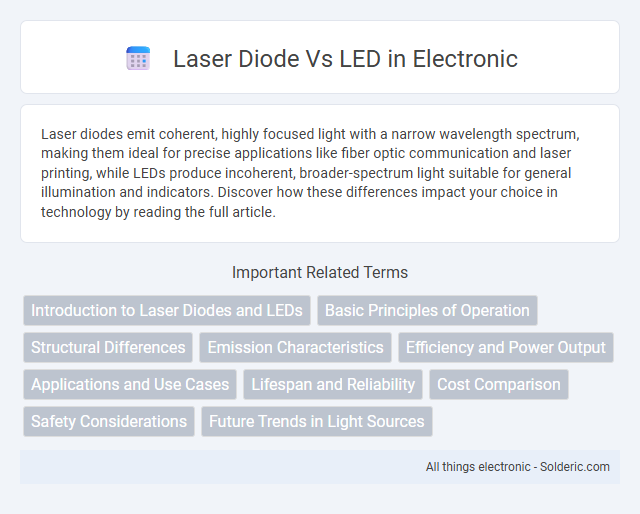Laser diodes emit coherent, highly focused light with a narrow wavelength spectrum, making them ideal for precise applications like fiber optic communication and laser printing, while LEDs produce incoherent, broader-spectrum light suitable for general illumination and indicators. Discover how these differences impact your choice in technology by reading the full article.
Comparison Table
| Feature | Laser Diode | LED |
|---|---|---|
| Light Emission | Coherent, monochromatic | Incoherent, broad spectrum |
| Output Power | High | Low to moderate |
| Beam Direction | Highly focused, narrow beam | Wide angle, diffuse |
| Efficiency | Higher electrical-to-optical conversion | Lower efficiency |
| Lifespan | Shorter, sensitive to heat | Longer, robust |
| Cost | Higher | Lower |
| Applications | Optical storage, fiber optics, laser pointers | Indicators, lighting, displays |
Introduction to Laser Diodes and LEDs
Laser diodes emit coherent, monochromatic light through stimulated emission, making them ideal for high-precision applications such as fiber optic communications and barcode scanners. LEDs (Light Emitting Diodes) produce incoherent, broad-spectrum light due to electron-hole recombination, commonly used in indicators, displays, and general lighting. Both devices are semiconductor sources but differ fundamentally in light coherence, spectral output, and applications.
Basic Principles of Operation
Laser diodes operate by stimulated emission within a semiconductor material, producing coherent and monochromatic light through a highly controlled population inversion in the active region. LEDs emit incoherent, broad-spectrum light generated by spontaneous recombination of electrons and holes in a p-n junction. The key difference lies in the laser diode's optical cavity structure, which amplifies light and allows for precise wavelength emission, while LEDs lack this resonant cavity, resulting in less directional and less intense illumination.
Structural Differences
Laser diodes feature a highly structured, p-n junction with an active region designed for stimulated emission, allowing coherent light output. LEDs possess a simpler, broad-area p-n junction that emits incoherent light through spontaneous emission. The laser diode's optical cavity and mirrors enable light amplification, distinguishing it structurally from the less complex LED without optical feedback mechanisms.
Emission Characteristics
Laser diodes emit coherent, monochromatic light with a narrow spectral linewidth and high intensity, making them ideal for precise applications such as optical communication and laser pointers. LEDs produce incoherent, broad-spectrum light with a wider emission angle, resulting in lower intensity but greater color variety, suitable for general illumination and display technologies. Your choice between a laser diode and an LED depends on whether you need focused, high-intensity illumination or diffuse, energy-efficient lighting.
Efficiency and Power Output
Laser diodes offer significantly higher efficiency and power output compared to LEDs, making them ideal for applications requiring intense, focused light. The coherent light emission of laser diodes enables concentrated energy delivery with minimal loss, resulting in superior luminous efficiency. Your choice between the two should consider the demand for precise, high-power illumination versus broader, lower-intensity lighting needs.
Applications and Use Cases
Laser diodes are commonly used in high-precision applications such as fiber-optic communications, barcode scanning, and laser printers due to their coherent and focused light output. LEDs find widespread use in general lighting, display backlighting, and indicator lights because of their energy efficiency and longer lifespan. Both technologies are pivotal in automotive lighting and medical devices, with laser diodes favored for surgical tools requiring fine precision and LEDs for illumination and signaling purposes.
Lifespan and Reliability
Laser diodes generally offer a longer lifespan and higher reliability compared to LEDs due to their more robust semiconductor materials and precise manufacturing processes. While LEDs typically have an average lifespan of 25,000 to 50,000 hours, laser diodes can exceed 50,000 hours under optimal operating conditions. The stable output and reduced thermal degradation of laser diodes contribute significantly to their enhanced durability in demanding applications.
Cost Comparison
Laser diodes typically have a higher initial cost compared to LEDs due to their complex manufacturing processes and specialized materials. LEDs are generally more cost-effective for mass-market applications, benefiting from widespread production and lower material expenses. Both technologies offer different value propositions, with laser diodes excelling in performance-intensive uses despite higher price points.
Safety Considerations
Laser diodes emit coherent, high-intensity light that can cause eye damage if proper protective measures, such as safety goggles, are not used, making them more hazardous than LEDs. LEDs produce incoherent, lower-intensity light, significantly reducing the risk of retinal injury, but they can still cause discomfort or minor burns at very high power levels. Regulations like IEC 60825-1 standard classify laser diodes by hazard levels, emphasizing the importance of controlled exposure and safety protocols in industrial and medical applications.
Future Trends in Light Sources
Laser diodes exhibit higher coherence and power efficiency compared to LEDs, driving their adoption in advanced optical communication and sensing applications. Emerging trends indicate a shift towards integrating laser diodes with silicon photonics to enhance data transmission speeds and reduce energy consumption. Innovations in nanostructured materials and quantum dot technology are expected to further improve the performance and versatility of laser diodes over traditional LEDs.
Laser diode vs LED Infographic

 solderic.com
solderic.com